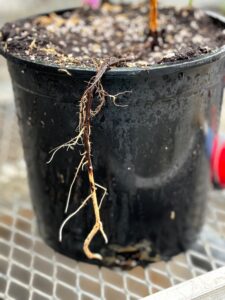Producing Fibrous-Rooted Hickories Towards Commercial Production and Improved Transplanting
Producing Fibrous-Rooted Hickories Towards Commercial Production and Improved Transplanting
2022 Barborinas Family Fund Grant
Carya species, commonly referred to as hickories, include many stately, native trees, that offer superior ornamental and adaptable features with great promise for application in managed landscapes, especially urban environments. Additionally, nursery stock of species such as Carya illinoinensis (pecan), Carya laciniosa (kingnut hickory), and Carya ovata (shagbark hickory) are sought after due to their production of desirable nuts and potential for use in edible landscapes. Immense interest exists in effectively producing these trees, however, due to their lag-phase shoot growth and strong development of a taproot with minimal fibrous-root branching, these trees exhibit resistance to standard growing techniques and reduced transplant success.
This study will develop new protocols to enable nursery growers and those that manage landscapes to produce and successfully transplant multiple species of highly desirable hickories using the etiolated stool bed method. We have concentrated on Carya ovata, the most difficult to grow in nursery production.
Study Results:
Initially we tried to replicate the previous experiment where Carya ovata and other Hickories were cut back, etiolated in the field and treated with IBA. A PVC core was placed on top of the shoots and a soilless potting mix added to the core, almost covering the newly emerging shoots. Unfortunately, weather in the field blew over the cores and soilless mix within them.
We then endeavored to replicate this experiment in a greenhouse here we had more control. Two hundred 2-year-old Carya ovata seedlings were cut back to 8:” (20 cm) placed in the dark to etiolate the newly emerging shoots and treated with IBA. A PVC core was placed on top of the containers and soilless mix added to the cores. They were harvested after 6 months but no roots emerged. After allowing the seedlings to undergo a chilling period of 4 months, the potted Hickories were again taken into the greenhouse and placed under backcloth to etiolate the newly emerging shoots. This time we cut the shoots back to 0.5 inch(1cm) from the base of the stem.
The same process of etiolation, IBA treatment, and cores with soilless mix was applied. This experiment is still in process; however, we have had promising results when checking a few of the pots. Highly branched roots have emerged from the base of the new shoot. See pictures




To propagate Carya ovata, severe cutting back of seedling stem is necessary to give rise to juvenile shoots that will root after exposed to etiolation and IBA treatment.
This is best achieved in the greenhouse where conditions can be controlled.
A container layering system is developed where etiolated juvenile shoots are treated with IBA and them partially covered with a PVC cone placed on top of the container. The cores are filled with a soilless medium and kept moist for 4-6 months after which new roots emerge from the base of the etiolated shoot. These roots are highly branched, not at all like the severe tap root in the container. The rooted shoot can then be removed from the original seedling and grown on.
Year of Grant Awarded: 2022
Grant Program: Barborinas Family Fund Grant Program
Grant Title: Producing Fibrous-Rooted Hickories Towards Commercial Production and Improved Transplanting
Researcher: Dr. Nina Bassuk, Cornell University
